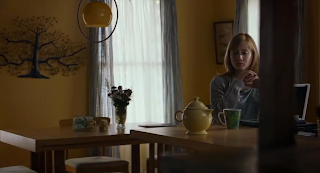It seems that the film, The
Man With a Movie Camera, doesn't exactly follow a narrative (the only relating aspect of the film is that each shot depicts the lifestyle of a photographer), Pudovkin's concept of constructive editing is
not being used in this film. Constructive editing is the idea that each shots should be related to each other through having purpose within the narrative. Therefore, if there is no story, there is nothing to relate to. In
contrast, the decidedly less experimentalThe
Bicycle Thief does
indeed follow a story. Constructive editing occurs in the above clip from 0:21 to 2:37; each shot can be related and arranged in a sequence so as reveal an important part of the story through consecutive cuts - he ultimately makes decision to send
Bruno home on the streetcar and to steal the seemingly-abandoned
bicycle, and we can figure this out through the use of constructive editing.
An example of the Kuleshov effect in The Man With a Movie Camera is from 3:13 to 3:29. The two paintings, one of an old man and the other of a man and a woman, are cut to between shots of a woman in bed. These in a sense exemplify how Vertov wished for the audience to react to the woman; the first expresses curiosity, while the second displays concern and even hate. In The Bicycle Thief, the film uses the Kuleshov effect at 4:58: The owner of the bicycle that Antonio attempted to steal, glances to his side and notices Antonio's son Bruno. The reaction that follows suggests that the owner feels pity towards Antonio and lets him loose.
Eisensteinian montage occurs in both of these films. The Man With a Movie Camera's theater sequence, from 0:40 to 2:57, uses incomplete shots more significant to the sequence as a whole than to themselves. They include shots of everything from musicians to people on the streets doing every-day tasks(even walking). The usage of the montage in this film creates a sense of setting in the film. It makes the audience feels as if they are following around the "Man" as he films his movie. Eisensteinian montage is used very frequently in The Bicycle Thief as well when Antonio ponders stealing the bike. There are cuts between the bike and Antonio as he ponders his decision. In this way, it expresses his confusion through the editing style.
The Man With a Movie Camera does not use realist editing techniques; it contains frequent cuts, meaning that there is lots of cutting and editing, veering it away from the realist conventions. Therefore, the film does not utilize realist editing. One use of realist editing in The Bicycle Thief is when Antonio has stolen the bicycle and is being pursued (2:39 to 4:41). There is very little editing done, and it is clear that the only cuts come with insertion of shorter takes inside of long takes.
An example of the Kuleshov effect in The Man With a Movie Camera is from 3:13 to 3:29. The two paintings, one of an old man and the other of a man and a woman, are cut to between shots of a woman in bed. These in a sense exemplify how Vertov wished for the audience to react to the woman; the first expresses curiosity, while the second displays concern and even hate. In The Bicycle Thief, the film uses the Kuleshov effect at 4:58: The owner of the bicycle that Antonio attempted to steal, glances to his side and notices Antonio's son Bruno. The reaction that follows suggests that the owner feels pity towards Antonio and lets him loose.
Eisensteinian montage occurs in both of these films. The Man With a Movie Camera's theater sequence, from 0:40 to 2:57, uses incomplete shots more significant to the sequence as a whole than to themselves. They include shots of everything from musicians to people on the streets doing every-day tasks(even walking). The usage of the montage in this film creates a sense of setting in the film. It makes the audience feels as if they are following around the "Man" as he films his movie. Eisensteinian montage is used very frequently in The Bicycle Thief as well when Antonio ponders stealing the bike. There are cuts between the bike and Antonio as he ponders his decision. In this way, it expresses his confusion through the editing style.
The Man With a Movie Camera does not use realist editing techniques; it contains frequent cuts, meaning that there is lots of cutting and editing, veering it away from the realist conventions. Therefore, the film does not utilize realist editing. One use of realist editing in The Bicycle Thief is when Antonio has stolen the bicycle and is being pursued (2:39 to 4:41). There is very little editing done, and it is clear that the only cuts come with insertion of shorter takes inside of long takes.






























